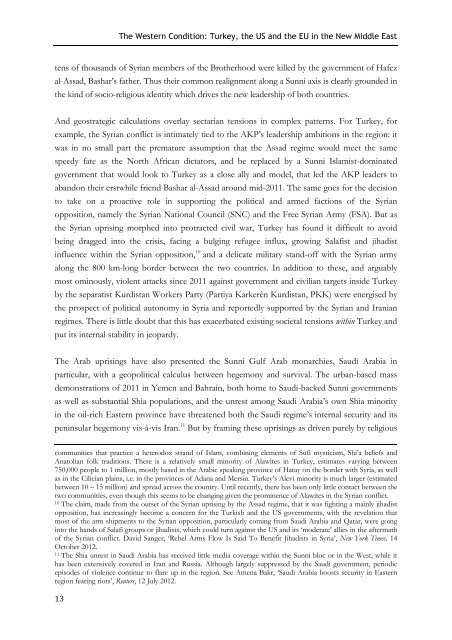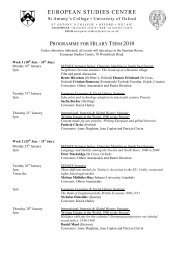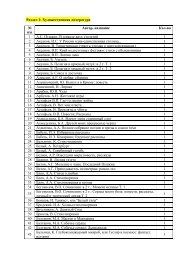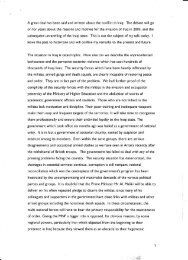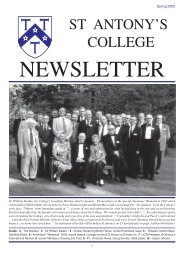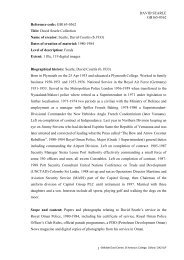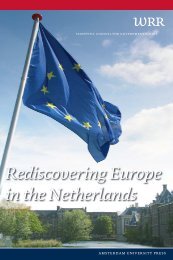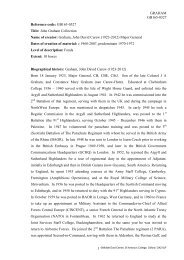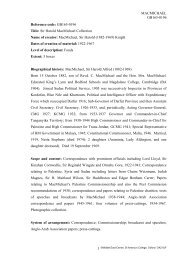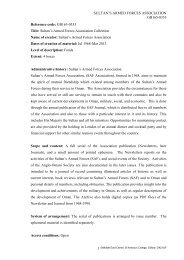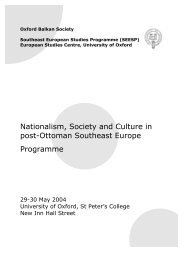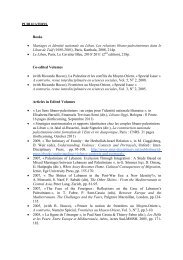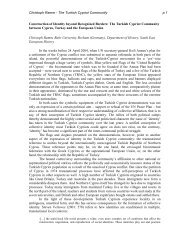The Western Condition - St Antony's College - University of Oxford
The Western Condition - St Antony's College - University of Oxford
The Western Condition - St Antony's College - University of Oxford
Create successful ePaper yourself
Turn your PDF publications into a flip-book with our unique Google optimized e-Paper software.
<strong>The</strong> <strong>Western</strong> <strong>Condition</strong>: Turkey, the US and the EU in the New Middle East<br />
tens <strong>of</strong> thousands <strong>of</strong> Syrian members <strong>of</strong> the Brotherhood were killed by the government <strong>of</strong> Hafez<br />
al-Assad, Bashar’s father. Thus their common realignment along a Sunni axis is clearly grounded in<br />
the kind <strong>of</strong> socio-religious identity which drives the new leadership <strong>of</strong> both countries.<br />
And geostrategic calculations overlay sectarian tensions in complex patterns. For Turkey, for<br />
example, the Syrian conflict is intimately tied to the AKP’s leadership ambitions in the region: it<br />
was in no small part the premature assumption that the Assad regime would meet the same<br />
speedy fate as the North African dictators, and be replaced by a Sunni Islamist-dominated<br />
government that would look to Turkey as a close ally and model, that led the AKP leaders to<br />
abandon their erstwhile friend Bashar al-Assad around mid-2011. <strong>The</strong> same goes for the decision<br />
to take on a proactive role in supporting the political and armed factions <strong>of</strong> the Syrian<br />
opposition, namely the Syrian National Council (SNC) and the Free Syrian Army (FSA). But as<br />
the Syrian uprising morphed into protracted civil war, Turkey has found it difficult to avoid<br />
being dragged into the crisis, facing a bulging refugee influx, growing Salafist and jihadist<br />
influence within the Syrian opposition, 10 and a delicate military stand-<strong>of</strong>f with the Syrian army<br />
along the 800 km-long border between the two countries. In addition to these, and arguably<br />
most ominously, violent attacks since 2011 against government and civilian targets inside Turkey<br />
by the separatist Kurdistan Workers Party (Partiya Karkerên Kurdistan, PKK) were energised by<br />
the prospect <strong>of</strong> political autonomy in Syria and reportedly supported by the Syrian and Iranian<br />
regimes. <strong>The</strong>re is little doubt that this has exacerbated existing societal tensions within Turkey and<br />
put its internal stability in jeopardy.<br />
<strong>The</strong> Arab uprisings have also presented the Sunni Gulf Arab monarchies, Saudi Arabia in<br />
particular, with a geopolitical calculus between hegemony and survival. <strong>The</strong> urban-based mass<br />
demonstrations <strong>of</strong> 2011 in Yemen and Bahrain, both home to Saudi-backed Sunni governments<br />
as well as substantial Shia populations, and the unrest among Saudi Arabia’s own Shia minority<br />
in the oil-rich Eastern province have threatened both the Saudi regime’s internal security and its<br />
peninsular hegemony vis-à-vis Iran. 11 But by framing these uprisings as driven purely by religious<br />
communities that practice a heterodox strand <strong>of</strong> Islam, combining elements <strong>of</strong> Sufi mysticism, Shi’a beliefs and<br />
Anatolian folk traditions. <strong>The</strong>re is a relatively small minority <strong>of</strong> Alawites in Turkey, estimates varying between<br />
750,000 people to 1 million, mostly based in the Arabic speaking province <strong>of</strong> Hatay on the border with Syria, as well<br />
as in the Cilician plains, i.e. in the provinces <strong>of</strong> Adana and Mersin. Turkey’s Alevi minority is much larger (estimated<br />
between 10 – 15 million) and spread across the country. Until recently, there has been only little contact between the<br />
two communities, even though this seems to be changing given the prominence <strong>of</strong> Alawites in the Syrian conflict.<br />
10 <strong>The</strong> claim, made from the outset <strong>of</strong> the Syrian uprising by the Assad regime, that it was fighting a mainly jihadist<br />
opposition, has increasingly become a concern for the Turkish and the US governments, with the revelation that<br />
most <strong>of</strong> the arm shipments to the Syrian opposition, particularly coming from Saudi Arabia and Qatar, were going<br />
into the hands <strong>of</strong> Salafi groups or jihadists, which could turn against the US and its ‘moderate’ allies in the aftermath<br />
<strong>of</strong> the Syrian conflict. David Sanger, ‘Rebel Arms Flow Is Said To Benefit Jihadists in Syria’, New York Times, 14<br />
October 2012.<br />
11 <strong>The</strong> Shia unrest in Saudi Arabia has received little media coverage within the Sunni bloc or in the West, while it<br />
has been extensively covered in Iran and Russia. Although largely suppressed by the Saudi government, periodic<br />
episodes <strong>of</strong> violence continue to flare up in the region. See Amena Bakr, ‘Saudi Arabia boosts security in Eastern<br />
region fearing riots’, Reuters, 12 July 2012.<br />
13


